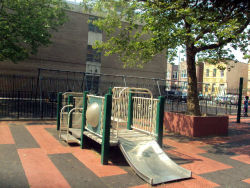Chester Playground
Chester Playground
Chester Playground is located in the Brownsville section of Brooklyn, a neighborhood bounded to the north by Eastern Parkway, to the east by Van Sinderen Avenue, to the south by Linden Boulevard and to the west by Rockaway Parkway.
In 1865, Charles S. Brown purchased a section of farm and meadowland in this area and built 250 frame houses. He hoped to lure the working class from lower Manhattan and western sections of Brooklyn to live in his modestly priced homes. Brown was certain that he would not be able to convince wealthier people to relocate because the area was affected by the odors from the marshes and bone-boiling factories of Jamaica Bay.
Brownsville’s development proceeded slowly, due to both the lack of major mass transit facilities in the area as well as general lack of interest in what was still a rural outpost of Brooklyn. It remained essentially a farming village until 1887, when Jewish real estate agent Aaron Kaplan purchased local lots. There he built tenement housing and began to draw significant numbers of Jews from the Lower East Side seeking to escape the overcrowding.
With the opening of the Fulton Street elevated railway in 1889 and the Williamsburg Bridge in 1903, the population of Brownsville ballooned. By 1910, the neighborhood was crowded with tenements. Brownsville had become just the sort of place that immigrants from the Lower East Side were seeking to escape -- there were no sewers or paved streets, sweatshops and pushcarts abounded. These conditions did improve in the decades that followed. The 1922 extension of the IRT provided better access to rapid transit. Brownsville became a center for radical movements, supporting socialist candidates to public office throughout the first half of the 20th century. Margaret Sanger, pioneer of women’s reproductive rights, opened America’s first birth control clinic at 46 Amboy Street in 1916.
The neighborhood has been home to many celebrities. Composer Aaron Copland hailed from Brownsville and writers such as Henry Roth and Alfred Kazin evoked these streets in their writing. In the 1930s, Lucky Luciano and his crime syndicate “Murder, Inc.” operated out of the area. Heavyweight champions Mike Tyson and Riddick Bowe, comedian Jerry Lewis, and civil rights activist Mother Rosetta Gaston also spent time here. Like many neighborhoods throughout the five boroughs, Brownsville experienced decline during the post-war years, however, new waves of residents, particularly from the Caribbean islands, have brought a renewed vibrancy to the community in recent years.
Parks acquired Chester Playground, located on the block bounded by Chester and Bristol Streets and Sutter and Pitkin Avenues, in 1964. City Council Member Priscilla A. Wooten allocated $1,565,000 in 1998 for a complete reconstruction of the park.
The park offers basketball and handball courts, a painted baseball diamond, shower basin, tot and regular swings, and colorful play equipment. Notable features abound, such as a yellow sun compass stone, a stone that highlights the date based on a human shadow, and small yellow and red “CP” (the park’s initials) squares on the wrought iron fences. World’s Fair benches and trees, including London plane trees (Platanus x acerifolia), beautify the area.
Check out your park's Vital Signs
Clean & Safe
Green & Resilient
Empowered & Engaged Users
Share your feedback or learn more about how this park is part of a
Vital Park System

